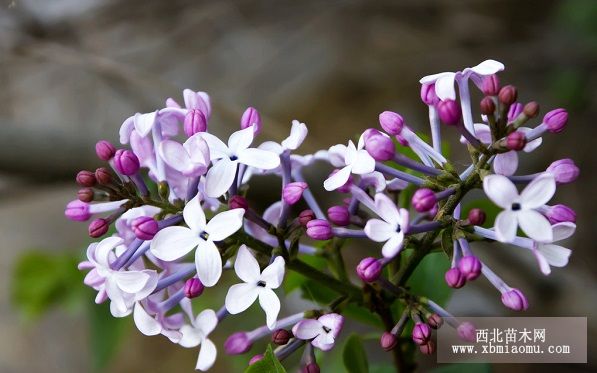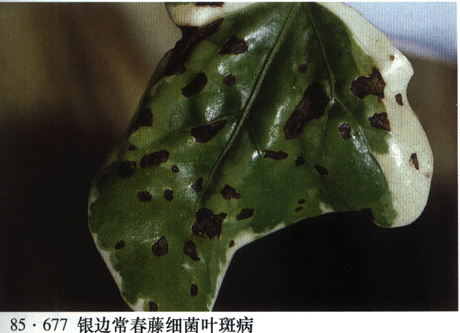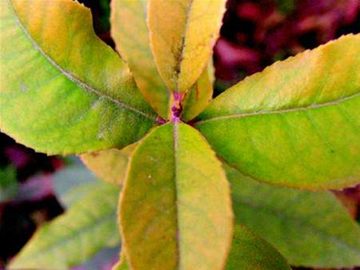Clove brown spot
Symptoms and pathological changes: mainly formed brown spots on the leaves, disease spots round, nearly round or irregular, dark brown edge, light brown center, severe brown spots, early defoliation, leaving only a small number of leaves in the whole plant. The pathogen is fungus, Cercospora lilac, the seed is spherical, dark brown, the conidia are fascicled and erect. Conidia linear or clavate, colorless or nearly colorless, septate, basal cells obconical, obtusely round or nearly flat. The pathogen overwintered with constellation or hyphae in diseased fallen leaves, and it was infected from May to June. Under rainy and humid conditions, the pathogen repeatedly spread the infection harm, so the disease occurred seriously in most years of Rain Water. When it is rainy in autumn, the disease is serious.
Prevention and control methods: 1. Remove the diseased leaves in autumn and winter, trim and reshape in time during the growing period, and control the density of branches and leaves to facilitate ventilation and light transmission. In peacetime management, it is necessary to apply water and fertilizer reasonably and drain water in time. 2, chemical control: spraying 1000 times of 50% carbendazim or 75% chlorothalonil wettable powder, 80% Dysen zinc wettable powder, etc., once every 15 days, 2 times continuously, can prevent and cure the disease.

1.5-4 m tall, bark grayish brown, branchlets yellowish brown, initially pubescent. And then gradually fall off. Young leaves clustered, posterior opposite, ovate, Obovate or lanceolate, panicles, flowers lavender, purplish red or blue, Corolla tube 6-8mm long. The florescence is from May to June.
At the initial stage of the onset of clove black spot symptoms, there are chlorotic spots on the leaves, gradually expanding to round or subcircular spots, 3mm in diameter, brown or dark brown, with rims but not obvious. The disease spot becomes grayish brown in the later stage, with dense black mildew spots, which are the conidia and conidiophores of the pathogen. The disease spots are connected to each other so that a large part of the leaves are brown, withered, shrunk or even shattered. Pathogens and pathogenic characteristics pathogens are a kind of fungi in Alternaria. Conidiophores scattered or several roots collected, brown; conidia brown. The disease overwintered on the diseased leaves with mycelium or conidia and spread with Rain Water dripping. Symptoms of clove brown spot the spot on the clove leaf is polygonal, irregular or round to subround, brown, 5mm in diameter. In the later stage of the lesion, the central tissue becomes grayish brown, and the edge of the spot is dark brown. There is a dark gray mold layer on the lower epidermis of the disease spot, that is, the conidia and conidiophores of the pathogen. When the disease is serious, there is also a small amount of mold layer on the front of the disease spot. The disease spots are connected to each other into large patches, showing a grayish brown blight. The pathogen and pathogen is Syringa. The pathogen overwinters on the deciduous leaves with spore seat or mycelium, and the conidia are transmitted by wind and rain. Too much Rain Water, heavy dew, high planting density and poor ventilation can easily lead to diseases. At the initial stage of the symptoms of clove spot blight, nearly round, polygonal or irregular spots were scattered on both sides of the leaves. The edge of the lesion is dark, and the central tissue is light and grayish brown. In the later stage of the disease, a small number of black dots appeared in the center of the lesion, that is, the conidium of the pathogen. The pathogen and disease characteristics of the pathogen is syringomycetes, the pathogen overwintered on the diseased leaves by conidia, and the conidia were transmitted by wind and rain. Control measures to reduce the source of infection. Remove the diseased and disabled body; carry out moderate pruning to cut off diseased and withered shoots. Spraying 1% equal amount of Bordeaux solution, 70% methyl thiophanate wettable powder 1000 times, 10 murine once every 15 days, spraying 3 Mel 4 times had better effect. How to prevent and cure clove brown spot?
Lilac (Syringa oblata Lindl.) is a deciduous shrub or small tree. Also known as cloves, North China lilacs, hundred knots, lovers, dragon tips. Lilac is native to North China and has been cultivated in China for more than 1000 years. It is a precious flower in China.
1.5-4 m tall, bark grayish brown, branchlets yellowish brown, initially pubescent. And then gradually fall off. Young leaves clustered, posterior opposite, ovate, Obovate or lanceolate, panicles, flowers lavender, purplish red or blue, Corolla tube 6-8mm long. The florescence is from May to June.
Brown disease spot often occurs on clove leaves, which is called clove brown spot. The plaque is round, subround or irregular with a wheel pattern, dark brown at the edge, light brown at the center, 5 to 10 mm in diameter and black mildew. When the disease is serious, the leaves are covered with disease spots, and the leaves fall off ahead of time. The pathogen of clove brown spot is a fungus of the genus Cercospora. The pathogen overwintered in the diseased and residual leaves and spread by wind and rain from May to June of the second year. Under the rainy and humid condition, the bacteria spread the infection harm repeatedly, so the disease occurred seriously in most years of Rain Water. The measures for the prevention and control of incense brown spot are as follows: first, the withered branches and leaves are burned in time to eliminate the source of overwintering disease. Second, when planting cloves, do not be too dense between plants. In peacetime management, it is necessary to apply water and fertilizer reasonably and drain water in time. Third, chemical control, 50% carbendazim wettable powder 1000 times liquid or 75% chlorothalonil wettable powder 1000 times liquid Dysen zinc wettable powder can be sprayed once every semimonthly for 3 times in a row.
- Prev

Ivy leaf spot
Symptoms and pathological changes: in the early stage of the disease, there were small round dark spots on the leaf surface with oily halo. After the expansion, it is black. Some become polygonal, sometimes there are brown deposits around the spot, and occasionally ulcer spots occur on the petiole. The infected leaves do not fall off. The disease overwinters in the diseased tissue.
- Next

Gardenia yellowing disease
Symptoms and pathological changes: chlorosis is an important physiological disease of gardenia. The disease is widely distributed and is common in the north of the Yangtze River. The disease mainly occurs in the leaves, starting from the young leaves at the top, the leaves fade, the mesophyll between the veins is yellow, and then the veins are also faded, and the edges of the leaves are yellow and white. Last
Related
- Fuxing push coffee new agricultural production and marketing class: lack of small-scale processing plants
- Jujube rice field leisure farm deep ploughing Yilan for five years to create a space for organic food and play
- Nongyu Farm-A trial of organic papaya for brave women with advanced technology
- Four points for attention in the prevention and control of diseases and insect pests of edible fungi
- How to add nutrient solution to Edible Fungi
- Is there any good way to control edible fungus mites?
- Open Inoculation Technology of Edible Fungi
- Is there any clever way to use fertilizer for edible fungus in winter?
- What agents are used to kill the pathogens of edible fungi in the mushroom shed?
- Rapid drying of Edible Fungi

